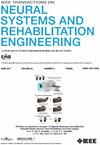脑卒中后步态额平面质心传递不对称性的时间演化
IF 4.8
2区 医学
Q2 ENGINEERING, BIOMEDICAL
IEEE Transactions on Neural Systems and Rehabilitation Engineering
Pub Date : 2025-04-10
DOI:10.1109/TNSRE.2025.3559857
引用次数: 0
摘要
在典型的人类步态中,身体重心(CoM)是循环地向每条下肢转移并由其支撑的。这种重心转移的大小可以通过测量每一步中重心与站立足之间的最小中外侧距离来量化。中风导致的偏瘫患者在轻瘫与非轻瘫时,往往表现出较低且更可变的CoM转移幅度,这与行走速度较慢和摔倒风险增加有关。虽然在初次接触时通常观察到的更宽和更可变的父母足位置可能导致这种额平面CoM传递异常,但其他因素可能在初次接触后继续调节CoM传递幅度。为了了解在整个传递过程中,CoM传递幅度是如何演变的,我们推导了一个基于倒立摆的方程,该方程将实验测量的瞬时中外侧CoM位置和速度投影到CoM传递幅度上。首先利用被动倒立摆动力学方法,通过双支撑期结束时的CoM位置和速度预测CoM的传递幅度,验证了推导出的方程。然后,我们研究了在传递过程中,在亲亲和非亲亲步骤之间的预估CoM传递幅度的不对称性是如何演变的。我们的研究结果显示,大约54%的传递幅度不对称是在初次接触时建立的,主要受足部放置的影响,而另外38%是在双支撑阶段建立的,部分原因是来自非双亲肢的功输入减少。此外,在双亲步骤的双重支持阶段,转移幅度的变异性得到了增强。总的来说,本研究引入了一种基于物理的方法,能够在CoM迁移完成之前预测其迁移幅度,我们的研究结果强调了双重支持阶段对CoM迁移幅度和变异性的不对称性的重要贡献,这在以前很少被探索。我们的研究结果表明,这一阶段的生物力学因素,如后肢工作输入,可能是未来研究和治疗干预的关键目标。本文章由计算机程序翻译,如有差异,请以英文原文为准。
Temporal Evolution of Frontal Plane Center-of-Mass Transfer Asymmetry in Post-Stroke Gait
In typical human gait, the body center-of-mass (CoM) is cyclically transferred towards and supported by each lower extremity. The magnitude of this CoM transfer can be quantified by measuring the minimum mediolateral distance between the CoM and the stance foot during each step. Individuals with hemiparesis due to stroke often show a reduced and more variable CoM transfer magnitude in paretic versus non-paretic steps, which are linked to slower walking speeds and an increased risk of falling. While the commonly observed wider and more variable paretic foot placement at initial contact likely contributes to such frontal plane CoM transfer abnormalities, other factors could continue to adjust the CoM transfer magnitude after initial contact. To understand how the CoM transfer magnitude evolves throughout the transfer process, we derived an inverted-pendulum-based equation that projects the experimentally measured instantaneous mediolateral CoM position and velocity to the CoM transfer magnitude. We first validated our derived equation by demonstrating that CoM transfer magnitude can be predicted by the CoM position and velocity at the end of the double support phase with passive inverted pendulum dynamics. We then investigated how the asymmetry of this projected CoM transfer magnitude between the paretic and non-paretic steps evolves during the transfer process. Our findings revealed that about 54% of the transfer magnitude asymmetry was established at initial contact, predominantly influenced by foot placement, while another 38% was established during the double support phase, partly due to reduced work input from the non-paretic trailing limb. Additionally, the variability in transfer magnitude was augmented during the double support phase in paretic steps. Overall, the present study introduces a physics-based method capable of predicting CoM transfer magnitude in advance of its completion, and our findings highlight the significant contribution of the double support phase, which was previously less explored, to the asymmetries in CoM transfer magnitude and variability. Our results suggest that biomechanical factors during this phase, such as trailing limb work input, could be critical targets for future research and therapeutic interventions.
求助全文
通过发布文献求助,成功后即可免费获取论文全文。
去求助
来源期刊
CiteScore
8.60
自引率
8.20%
发文量
479
审稿时长
6-12 weeks
期刊介绍:
Rehabilitative and neural aspects of biomedical engineering, including functional electrical stimulation, acoustic dynamics, human performance measurement and analysis, nerve stimulation, electromyography, motor control and stimulation; and hardware and software applications for rehabilitation engineering and assistive devices.

 求助内容:
求助内容: 应助结果提醒方式:
应助结果提醒方式:


